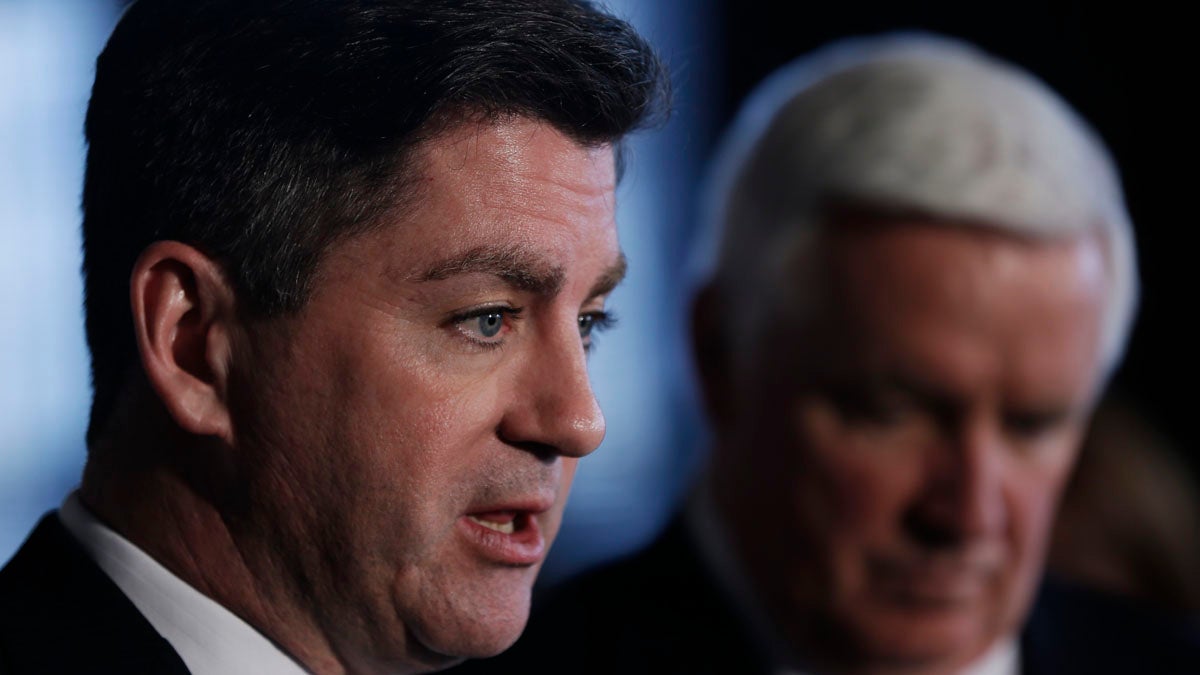Campaign ad returns Pa. focus to education spending

Pennsylvania Lt. Gov. Jim Cawley,left, and Gov. Tom Corbett appear in Philadelphia in 2013. (AP file photo)
Education funding cuts are front and center once again in a tiff between Pennsylvania’s candidates for governor.
A television attack ad that surfaced last week highlights the issue, which has dogged Republican incumbent Gov. Tom Corbett in the polls for years.
In the spot, a narrator says Corbett “cut nearly a billion dollars from education, forcing schools districts to fire 20,000 teachers and staff.”
On Monday, Lt. Gov. Jim Cawley denounced the television attack ad and the administration’s opponents.
“For three and a half years they have lied through their teeth,” Cawley said. “And shame on us for not being louder and calling it exactly what it is — a damn lie.”
The Corbett administration maintains that the money cut from education in 2011 was simply federal stimulus dollars that weren’t replaced because the governor was sticking to a no-tax promise.
But a third of the money cut was state funding, as the Morning Call has reported.
The roughly $355 million cut had, in years prior, gone into grants for early education and police officers, as well as reimbursements to school districts losing students to charter schools.
Cawley called for Democratic gubernatorial challenger Tom Wolf to have the ad removed. But spokesman Jeff Sheridan said the Wolf campaign can’t coordinate with the ad’s funder, an independent PAC called PA Families First. Moreover, said Sheridan, the campaign doesn’t dispute the ad’s claim.
Education advocates say the effect of recent annual state budgets is plain to see. Federal data show that more than 23,000 school employees lost jobs in 2011 and 2012 in Pennsylvania. In a 2014 survey, nearly 42 percent of responding school districts planned to furlough teachers. The same report shows academic offerings are being scaled back as class sizes are increasing.
The Corbett administration has argued that these pressures are in large part due to rising pension contributions. A state law that went into effect in 2011 increased what schools have to pay toward their employees’ pension fund. Advocates say state aid that goes toward pension payments shouldn’t count as education funding. Cawley dismissed that argument.
“When you run an enterprise … at least, everywhere else certainly in the private sector, everywhere else that I’m aware of, part of the expense of running that enterprise is salary and benefits for your employees,” Cawley said.
When asked about layoffs, he said the Corbett administration cannot answer for decisions made by individual school districts.
“We rely a great deal on local leadership of the 500 school districts to make decisions that are in the best interests of the people within their communities,” Cawley said. “So as far as any specific, regarding any specific school district, I think the question would be best left to them to answer.”
WHYY is your source for fact-based, in-depth journalism and information. As a nonprofit organization, we rely on financial support from readers like you. Please give today.




